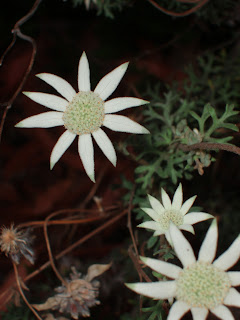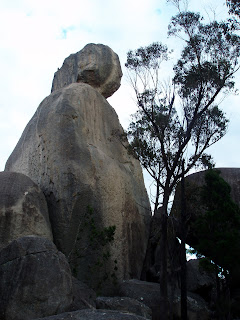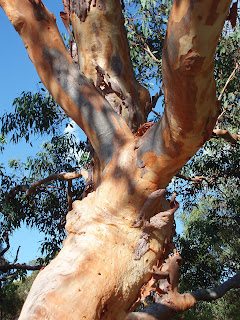Katoomba, a small town in the Blue Mountains renowned for its hiking, rock-climbing and caving is a short train ride, 120 west of Sydney. I had expected, given the name ‘Blue Mountains’ to be greeted by spectacular alpine scenery on arrival. I was some what disappointed when there wasn’t so much as a rolling hill on the horizon. I turns out that Katoomba is on top of the mountain, and geologically speaking the region isn’t mountainous but a high plato and network of steep canyons and valleys. A short walk from the hostel in the centre of town reveals the spectacular scenery, which doesn’t tower above you but drops away vertically beneath your feet.
The Three Sisters sandstone rock formations and the Jamison valley.
The vast canyons have eroded more than 500m down through layers of sandstone, shale and clay. The cliff edges drop vertically more than 100m down to the forests blanketing the valley floor. Looking down there are distinct changes in vegetation from rain forest at the bottom of the valleys, supported by plentiful ground water rather that abundant rain fall, which is dark green and has a notable absence of Eucaliptus, of which there are over 100specied in the Blue Mountains alone. Rising up the slopes are the wet sclerophyll forests dominated by tall open stands of Eucalyptus with open canopies more that 60m in height, with an under story of soft leaved trees, climbers and grasses. Following layers of clay within the sandstone cliffs are hanging swamps where the ground water peculates out above the clay forming bands of mosses and ferns that eventually drop from the cliff faces under their own weight. Finally the top of the plato consists of dry sclerophyll forests of open shorter, stands of Eucalyptus with a shrubby under story of flowering shrubs with small, tough spiny leaves.

One of the smaller tree species forming the under story of the forest in the botom of the canyon. I’ll let you know what it is when I find out.
The blue colouration of the mountains is down to the glaucus colour of the Eucalyptus leaves through the haze. Dropping down into the canyons down steep flights of steps carved into the rocks the atmosphere becomes noticeably cooler as you enter the humidity of the forest. Two trees dominate this part of the reserve, the Blue Mountain Gum Eucalyptus deanei with id towering smooth white bark and the Turpentine tree Syncarpia glomulifera with depictured bark, many of the trees burnt out completely in the core of the trunk by past fire storms and still supporting lush canopies. Tall tree ferns Cyathea australis lined the paths along with shorter squatter Dicksonia antarctica.
Blue Mountain Gum Eucalyptus deanei
Turpentine tree Suncarpia glomulifera
It was my first impulse to head straight down into the rainforests, however it turned out to be the high open forests on the tops of the canyons that support the most diverse range of flowers. Here the soil is much drier and nutrient poor as they are leached to the valley floor. The scrub consists of many different varieties of Acacia, Boronia, Grevellia, Hakea and pea plants (family FABACEAE) according to my book on wild flowers. There were many Banksias with remnants of past flowers and tough woody seed capsules that guard against fire, that unfortunately had finished flowering. There were other members of PROTEACEAE in flower along with many other wild flowers.
Isopogon anemonifolius PROTEACEAE
Banksia Eric folia PROTEACEAE
Telopia speciosa PROTEACEA
Lambertia Formosa PROTEACEAE
As is always the way I took pictures until the battery in my camera could carry on no more. Literally minuets after I rounded a corner and discovered not one but two different orchids in full bloom. My camera mustered up enough strength to take a quick snap or each. Fortunately they were not too far out so I hiked back up to the early the next morning, when the light was much more amenable of photography to take some more. The pale pink, butterfly shaped orchid has a mechanical anther which when the flower is genteelly touched, flicks suddenly like the arm of a catapult delivering a sticky package of pollen onto the back of an unsuspecting insect.
Haven’t been able to name these yet either, sorry!






























































































































